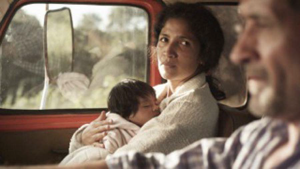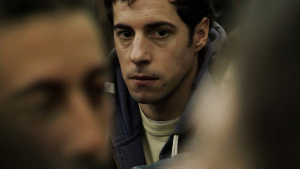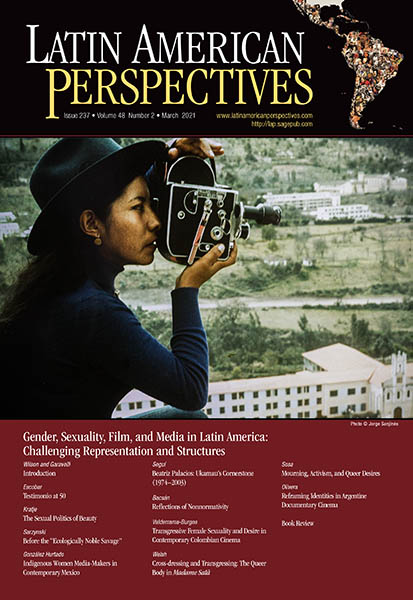 By: Tomás Crowder-Taraborrelli
By: Tomás Crowder-Taraborrelli
One cannot be short of themes while there is still plenty of reality. Any hour of the day, any place, any person, is a subject for narrative if the narrator is capable of observing and illuminating all these collective elements by exploring their interior value.
—Cesare Zavattini
Armando Bo’s feature film debut The Last Elvis (El último Elvis) is a refreshing addition to recent Argentine releases. Bo is the grandson of Armando Bo Senior, the director of the soft-porn pulp classics of Isabel “La Coca” Sarli (Fiebre, 1972, and Carne, 1968). He appears to share his grandfather’s fascination with the malcontent antiheroes that are ever present in our bustling Latin American cities. The Last Elvis follows the misadventures of Carlos Gutiérrez (John McInerny) over a period of a few days. Carlos makes his living impersonating Elvis Presley, singing at private parties and neighborhood fairs.
During the day Carlos (who insists on being called “Elvis,” as if the name were a title of nobility) works in an appliance factory. It is unclear whether he and his fellow workers on the line are assembling new appliances or refurbishing outmoded ones. His factory job speaks volumes about his own path as an artist. During a particularly reflective scene, he leaves the assembly line and walks through a maze of discarded stoves, presumably to take one of his breaks. It’s a stunning shot for its artistic qualities and narrative effect. Carlos lounges on a discarded sofa, feet propped up, listening to “the King” on his Sony Walkman Sport. Just like the rusted refrigerator lying on a heap of other appliances in the background, he is physically exhausted. As he moves into his forties, one wonders whether he is destined for refurbishing or for the dump.
The opening scene is equally provocative. A traveling shot leads the viewer up a set of marble stairs lined with brass railings as Richard Strauss’s Also Sprach Zarathustra builds in intensity. It is impossible for a director to use this music in a film without evoking Stanley Kubrick’s 2001: A Space Odyssey. The tone in Bo’s film is set for yet another cosmic encounter, but this time it is with the transformative energy of rock ‘n’ roll. Strauss’s composition turns out to be Carlos’s entrance music, which he follows with a delightful rendition of Elvis’s classic “See, See, Rider” (Figure 1). In the film as in Carlos’s performance, the execution is part of a plan. The impersonator copies the opening of Presley’s legendary concert Elvis Aloha from Hawaii, a television broadcast that was watched by millions in 1973. Elvis’s famous lyrics “Well, I’m going away, baby/And I won’t be back ‘til fall” form a central motif that sets the film’s plot in motion.
Without McInerny’s superb performance, The Last Elvis would be just another tragicomedy about a loser pretending to be a star. McInerny is especially memorable in this role because he is a real-life Elvis impersonator by night (an architect by day). Initially hired by Bo to coach the lead actor, McInerny turned out to be too good to pass up, and the director decided to replace the trained actor with the real deal.
Carlos doesn’t have many friends. He strikes the pose of a lonely artist seeking redemption. He is estranged from his wife, Alejandra (Griselda Siciliani), and his daughter, Lisa Marie (played by Margarita Lopez with great naturalness). He resents it when Alejandra doesn’t respond to the name “Priscilla” and scoffs at his daughter for not liking “the King’s” favorite sandwich—peanut butter and banana on white bread. His only visitor is a prostitute. While this could be construed as trite, the film positions this character as a kindred spirit; Carlos also prostitutes himself by assuming the persona of another artist for hire. When his ex-wife has a near-fatal car accident, Carlos is put in the position of having to assume fatherly duties, a role he has thus far managed to avoid.
A sense of doom saturates this film. Carlos is at odds not only with the times and his age but also with the Kafkaesque impersonators’ association that reimburses him for his gigs. This association is a celebrities’ purgatory. A rock connoisseur could surely identify in the crowd of familiar faces a Mick Jagger, an Iggy Pop, and a Charly García, to name a few.
Out of the meager salary he receives, Carlos is saving to travel to Graceland. His pilgrimage toward the end is the film’s memorable payoff. Bo and Nicolás Giacobone (credited for the screenplay) recognize that in popular culture, great art is mostly imitation, particularly in an age of digital reproduction. Carlos’s Elvis is as much a version of Elvis as Elvis himself, and this is what makes McInerny’s performance so disquieting; in a song we can ascertain the materialization, rise, and eventual downfall of two great performers.
There is a similar tone to Pablo Giorgelli’s Las acacias. The film is also a story of a marginal character, a single-minded truck driver whose judgment is stuck to the road ahead, but it has no references to pop culture, stardom, or cultural colonialism. Las acacias tells a simple tale and does so with confidence and weariness.
Little is said during the first 20 minutes or so. In the opening scene we witness an acacia tree being cut down with a chain saw. Latin American viewers, quick to pick up on regional languages and accents, will situate themselves at the border between Paraguay and Argentina, a region that has been devastated by indiscriminate logging for decades. Rubén (Germán de Silva) transports logs on a faded Scania truck; its purring engine provides the soundtrack for the first quarter of the film.
On this trip, Rubén is annoyed because he has been ordered to drive from the border to Buenos Aires (a long journey) with Jacinta (Hebe Duarte) and her 5-month-old baby girl, Anahí (Nayra Calle Mamani) (Figure 2). Not much is said between the two adults, but there is no need for conversation. In contrast to many contemporary directors, Giorgelli clearly understands that relationships are built mostly on gestures rather than words.

Figure 2. From Las acacias: Nayra Calle Mamani, Hebe Duarte, and Germán de Silva. Courtesy of Las Acacias Film.
In the beginning, Rubén is purposely rude to Jacinta. He drinks without offering, lights a cigarette in front of the baby, and doses off at the wheel (something that he later tries to deny). During these first tense scenes, the camera is mostly confined to the truck’s cabin, and we begin to crave the rare opportunity to peek at the passing landscape out of a window or in the dusty rear-view mirror. The outside world is only fleetingly reflected, and we begin to question Rubén’s ability to imagine life beyond these narrow frames.
The eyes of baby Anahí are interposed between Rubén’s callousness and Jacinta’s dignity. In Guaraní “Anahí” means the flower of the ceibo (Argentina’s national tree), esteemed for its beauty, and Anahí is beautiful. Both Rubén and Jacinta have turbulent pasts. As Jacinta firmly states, the baby has no father. Rubén met his son when he was four and hasn’t seen him since. He carries a picture of him in his glove compartment, perhaps to remind him of his missteps as a father. The road pushes the characters forward, and their relationship warms up. Viewers are left to evaluate what each character requires from the other and whether emptiness might be filled by their companionship. This is an antiquated tale, but the care with which it is handled by Giorgelli and Salvador Roselli (who collaborated on the screenplay) gives the film a distinguished glow.
On its screening at the esteemed Buenos Aires Festival Internacional de Cine Independiente, Santiago Mitre’s film The Student (El estudiante) was heralded as the beginning of a new era in Argentine independent film. The film is shot in digital HD, but the screenplay rests on the principles of classical filmmaking—an agreeable combination of the old and the new. Mitre coauthored Pablo Trapero’s Leonera (2008) and Carancho (2010), darlings of the international circuit, and his maturity is well displayed in The Student. What makes this new film a promising departure for him is that he manages to bring us even closer than usual to the social milieu of its protagonists.
Roque Espinosa (Esteban Lamothe), a slightly lazy college student, moves to Buenos Aires to attend the tumultuous University of Buenos Aires. He soon discovers (the passage of time in the film is marked by the girls he sleeps with) that he would much rather
Figure 2. From Las acacias: Nayra Calle Mamani, Hebe Duarte, and Germán de Silva. Courtesy of Las Acacias Film.
FILM REVIEW 139
meander through the poster-covered hallways and student centers spinning out political conspiracies than attend class.
The film marks Roque as a hunter (Figure 3). The Argentine rockers Los Natas provide untamed rhythms and distortions to anticipate or accompany the moments when he is mulling over his next move up the university’s barbed ladder. Roque favors, protects, enlists, and seduces colleagues and comrades with an ease that, from time to time, surprises even himself. Mitre must be thanked for not weighing the scenes down with expository dialogue. This is in fact one of the best qualities of his film—his ability to detach himself from the world he is exploring in order to reveal, humorously, its contradictions. The moralizing is left for those who find it necessary to expiate their political sins. Roque prefers action and expediency—he is a political beast.
The cinematography owes much to the documentary (shot on location, uneven camera work, natural lighting, real time). It moves swiftly among the students’ sit-ins and assemblies, often searching for a resting place from which to observe the conspiratorial carnage. Mitre uses some of the formal elements of social realism that we see in the other films reviewed here, but the acting, at times delicately stilted, gives the reality he depicts melodramatic overtones. He relies on the protagonist’s predatory stare to build tension and supplies the prey with a few redeeming features. Paula (Romina Paula), a well-intentioned teaching fellow, supplies several damning stare-downs that chip away at our loyalty to the unsung hero. An omniscient voice comments rather sarcastically on the species that inhabit the social system under scrutiny.
For viewers outside of Argentina, the academic world depicted in The Student, especially the ins and outs of the appointment of professors and deans, may remain mystifying, but the core of the conflict—the rise of a young political leader, closely monitored by his shifty mentor Alberto Acevedo (deftly played by Roque Felix)—is a popular theme in movies about drug pushers, human traffickers, and corrupt cops. For most of the film it remains unclear whether Roque will be able to find the principles and values that will give moral authority to his machinations. One can only hope that those would-be leaders will be driven not by personal ambition but by the yearnings of their communities. Wishful thinking, perhaps, but, as Roque reminds us in The Student, the ritual







